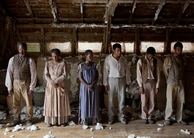Room for DebateIntelligent Design in the Complexity of the Human Body
By
2015, Vol. 7 No. 03 | pg. 2/2 | « Secular scholars will assert that the symmetry and patterns that are found in nature are just the byproduct of the brain’s inherent desire to notice symmetry and patterns. Atheist scholars will also assert that an omnipotent, omnibenevolent, and omniscient God would create beings with optimal design, and seeing as there are many flaws present in the human body God does not exist and therefore could not have possibly created human beings. This argument is known as the dysteleological argument, or argument from poor design. Secular author Jim Holt writes in his article “Unintelligent Design” that “Some nonfunctional oddities, like the peacock's tail or the human male's nipples, might be attributed to a sense of whimsy on the part of the designer (Holt.) Here Holt acknowledges that there are many useless and bizarre parts of the human anatomy as well as the anatomy of other animals. Holt then acknowledges the logical and epistemic value of this conundrum by stating that “what sort of designer would have fashioned creatures so out of sync with their environments that they were doomed to extinction?” (Holt.) In this statement, Holt is asserting that a benevolent creator could not logically create beings that were doomed to extinction or born with less than optimal body functions. This presents a large logical problem for intelligent design. If God is truly all good, why would He allow for imperfect beings to exist? When secular scholars and scientists examine biology where some see perfection, beauty and symmetry they see flaws and imperfection. They assert that random fluctuation and natural selection are both more viable explanations for the evolution of the human body. Chaos would be much more likely to breed these imperfections and flaws, a good God would have created optimal beings without flaws according to the argument from poor design. The argument from poor design does present a logical problem for intelligent design, but when examined further some of its claims are unsubstantiated. First, the argument is entirely contingent upon what human’s perceive to be optimal. This argument assumes that the human definition of optimal and the Creator’s definition are the same. There is no evidence to support this claim, and it rests entirely on an epistemic statement. Secondly, humans are unaware of the Creator’s goals and these imperfections may serve a purpose that we are entirely unaware of. Dr. Fazale Rana writes in her article “Responding to a Skeptic” that “it makes sense within the context of the biochemical intelligent design argument that, in some instances, suboptimal biochemical designs result from the Creator's intent. In other words, these biochemical systems are truly suboptimal, but intentionally so. But it's through this suboptimization that the Creator achieves overall optimal performance.” (Rana.) This statement supports the assertion that some parts of the human body are less optimal due to the high functionality of others. This system of biological trade offs functions as a vehicle for overall optimal function. As mentioned previously, the systems of the human body more often than not function in harmony to allow for optimal efficiency. While there may be some inconsistencies, overall the symmetry of human life and its mutualistic relationship with Earth seems to indicate a grand design, not random chance or chaos.Now, similar to my previous paper on cosmology and physics in intelligent design I will attempt some commonly used atheistic arguments in order to further assert my claim that a designer exists and it is responsible for the design of the human body and the cosmos. Often, atheists will assume the role of an enlightened individual that has left the bitter chains of spirituality in search for a higher academic calling. It is a common assertion in the atheist academic ethos that religion is dying out and will be obsolete in the next century, replaced by completely secular thought. However, when examining the statistics the exact opposite is true. The World Religions Database is a stockpile of stats regarding worldviews and faith systems of the world from historical trends to future predictions. According to a prediction table done by the WRD, Christianity is expected to gather over a billion new followers by 2050,. The same prediction holds true for Islam as well. In fact, the only world views that are expected to take a net loss in the next 40 years is agnosticism and atheism. All of these statistics are relative and are not based upon the fact that there are already less atheists than believers. They are to scale show that the idea that the world is quickly approaching secularism is just not true, in fact the world is expected to leave it fairly quickly. Human beings function in tandem with Earth, we have a naturally symbiotic relationship; an inherent mutualistic function. Humans exhale carbon dioxide and inhale oxygen; plants utilize our respiratory waste and produce oxygen so we can live. The argument for intelligent design in biology and anatomy is important because understanding how we truly came to be has been one of the most important life questions since the dawn of humankind. It is arrogant of humans to assume that we are the end-all in the universe; the epitome of innovation and advancement. The structure within our cells and their functions is a world in and of itself with vast functions and complexities. As we begin to better understand biology and anatomy as well as physics and cosmology in the universe, it is nigh impossible to deny the existence of a design. This fiery philosophical inquisitiveness present in every human desperately desires to know where we came from. Studying biology and the inner-machinations of the universe does just that. It leads us closer to understanding who we are and where we came from. If there is no higher designer, then what is the purpose of existential inquiry? Why bother studying the origins of the Universe? It seems that every human has the innate desire to better understand their origins, and I feel that by examining the beauty in symmetry one can find just that. In conclusion, with all of the wonder in nature and the beauty surrounding every being, it seems illogical to assume that all of it came through random chance. Yes evil exists, along with imperfection and flaws. All of these things are prominent. But the highly complex functions of human beings and their relationship with nature seem to warrant a belief in a grand designer. The argument from poor design makes heavy claims and assumptions that are unsubstantiated and based upon entirely epistemic assumptions. Some would say that intelligent design operates in the same way, but when nature is examined closely it seems impossible to ignore the design in its symmetry. ReferencesHarrub, Brad. “The Human Nervous System: Evidence of Intelligent Design [Part I]” Apologetics Press. Retrieved 5/7/2014 Whitwam, Ryan.” Simulating 1 second of human brain activity takes 82,944 processors” extremetech.com. august 5 2013. Retrieved 5/7/2014 Harrub, Brad. “The Unevolvable Circulatoy System” Apologetics Press. Retrieved 5/7/2014 Moore, Keith L., Marlene Herbst, and Megan Thompson. Essentials of Human Embryology. Toronto: B.C. Decker, 1988. Pg. 2 Safarti, Jonathan. “Refuting Evolution Part 2” creation .com. Retrieved 5/7/2014 Holt, Jim. “Unintelligent Design.” New York Times. August 20 2005. Retrieved 5/7/2014 Fazale, Rana. “Responding to a Skeptic” February 20 2009. Reasons. Org. Retireved 5/7/2014 World Religions Database Suggested Reading from Inquiries Journal
Inquiries Journal provides undergraduate and graduate students around the world a platform for the wide dissemination of academic work over a range of core disciplines. Representing the work of students from hundreds of institutions around the globe, Inquiries Journal's large database of academic articles is completely free. Learn more | Blog | Submit Latest in Opinion |


















